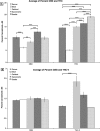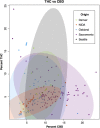Compromised External Validity: Federally Produced Cannabis Does Not Reflect Legal Markets
- PMID: 28422145
- PMCID: PMC5395929
- DOI: 10.1038/srep46528
Compromised External Validity: Federally Produced Cannabis Does Not Reflect Legal Markets
Abstract
As the most widely used illicit drug worldwide, and as a source of numerous under-studied pharmacologically-active compounds, a precise understanding of variability in psychological and physiological effects of Cannabis varieties is essential. The National Institute on Drug Abuse (NIDA) is designated as the sole legal producer of Cannabis for use in US research studies. We sought to compare the chemical profiles of Cannabis varieties that are available to consumers in states that have state-legalized use versus what is available to researchers interested in studying the plant and its effects. Our results demonstrate that the federally-produced Cannabis has significantly less variety and lower concentrations of cannabinoids than are observed in state-legal U.S. dispensaries. Most dramatically, NIDA's varieties contain only 27% of the THC levels and as much as 11-23 times the Cannabinol (CBN) content compared to what is available in the state-legal markets. Research restricted to using the current range of federally-produced Cannabis thus may yield limited insights into the chemical, biological and pharmacological properties, and medical potential of material that is available in the state markets. Investigation is urgently needed on the full diversity of Cannabis chemotypes known to be available to the public.
Conflict of interest statement
D.V. is the founder and president of the non-profit Agricultural Genomics Foundation. R.G., A.T., G.D., K.dC. and D.P.L. are employees of Steep Hill Labs. T.C.R. is an employee of S.C. Labs Inc. N.C.K. and K.E.H. are board members of the non-profit Agricultural Genomics Foundation.
Figures




References
-
- McPartland J. M., Matias I., Di Marzo V. & Glass M. Evolutionary origins of the endocannabinoid system. Gene 370, 64–74 (2006). - PubMed
-
- Hart C. L., Van Gorp W., Haney M., Foltin R. W. & Fischman M. W. Effects of acute smoked marijuana on complex cognitive performance. Neuropsychopharmacology 25, 757–765 (2001). - PubMed
Publication types
MeSH terms
Substances
Grants and funding
LinkOut - more resources
Full Text Sources
Other Literature Sources
Medical
Research Materials

